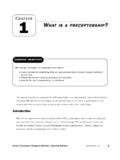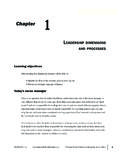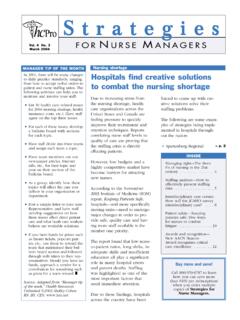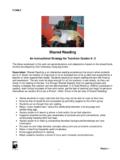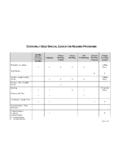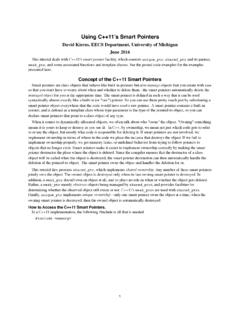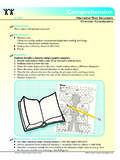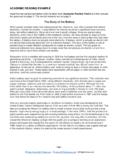Transcription of Introduction: The concept behind shared governance
1 1 SHAREDGOVERNANCE:A PRACTICAL APPROACH TO RESHAPING PROFESSIONAL NURSING PRACTICE 2006 HCPro, IncIntroduction: The concept behind shared governance Nursing is the protection, promotion, and optimization of health and abilities,prevention of illness and injury, alleviation of suffering through the diagnosis andtreatment of human response, and advocacy in the care of individuals, families,communities, and populations. American Nurses Association (2003)The increasingly critical shortage of professional nurses is a dangerous theme in response to it, more and more institutions are turning to shared governance a conceptChapter 1 Learning objectivesAfter reading this chapter, the participant should be able to do the following: Define the four primary principles of shared governance : partnership, equity, accountability, and ownership Compare two professional nursing practice models Describe the role of relational partnerships in shared governance 2 Chapter 1: introduction : The concept behind shared governanceSHAREDGOVERNANCE:APRACTICALAPP ROACH TO RESHAPING PROFESSIONAL NURSING PRACTICE 2006 HCPro, into healthcare organizations in the 1970s as an evidence-based method tocurb the shortage s damaging effects ( , negative patient outcomes, high cost of agencystaff, and RN sign-on bonuses).
2 This book takes some of the guesswork out of the variousstructures and processes behind shared governance and provides strategies, case examples,and best practices to make the daily operations of shared governance meaningful and suc-cessful. It also explores the relationship between shared governance and the MagnetRecognition Program by outlining the Magnet program expectations for shared gover-nance is shared governance ?Before it can be solved, a problem must be clearly defined. William FeatherIn its simplest form, shared governance is shared decision-making based on the principlesofpartnership, equity, accountability, and ownership at the point of service. This manage-ment process model empowers all members of the healthcare workforce to have a voice indecision-making, thus encouraging diverse and creative input that will help advance thebusiness and healthcare missions of the organization. In essence, it makes every employeefeel like he or she is part manager with a personal stake in the success of the feeling leads to longevity of employment increased employee satisfaction better safety and healthcare greater patient satisfaction shorter lengths of stayThose who are happy in their jobs take greater ownership of their decisions and are morevested in patient outcomes.
3 Therefore, employees, patients, the organization, and the sur-rounding communities benefit from shared 1: introduction : The concept behind shared governanceSHAREDGOVERNANCE:A PRACTICAL APPROACH TO RESHAPING PROFESSIONAL NURSING PRACTICE 2006 HCPro, IncFour principles of shared governanceIf shared governance is to allow for cost-effective service delivery and nurse empowerment,decision-making must be shared at point of service which means that the managementstructure must be decentralized. To make that happen, employee partnership, equity,accountability, and ownership must occur at the point of service ( , on the patient careunits). At least 90% of the decisions need to be made there. Indeed, in matters of practice,quality, and competence, the locus of control in the professional practice environment mustshift to practitioners. Only 10% of the unit-level decisions should belong to management(Porter-O Grady and Hinshaw 2005). Partnership links healthcare providers and patients along all points in thesystem; a collaborative relationship among all stakeholders and nursing requiredfor professional empowerment.
4 Partnership is essential to building relationships,involves all staff members in decisions and processes, implies that each memberhas a key role in fulfilling the mission and purpose of the organization, and iscritical to the healthcare system s effectiveness (Porter-O Grady and Hinshaw2005;Batson 2004). Equity the best method for integrating staff roles and relationships into struc-tures and processes to achieve positive patient outcomes. Equity maintains a focuson services, patients, and staff; is the foundation and measure of value; and saysthat no one role is more important than any other. Although equity does notequal equality in terms of scope of practice, knowledge, authority, or responsibili-ty, it does mean that each team member is essential to providing safe and effectivecare (Porter-O Grady and Hinshaw 2005; Batson 2004; Porter-O Grady, Hawkins,and Parker 1997). Accountability a willingness to invest in decision-making and express owner-ship in those decisions.
5 Accountability is the core of shared governance . It is oftenused interchangeably with responsibilityand allows for evaluation of role perform-ance (see Figure for characteristics of accountability and responsibility). Itsupports partnerships and is secured as staff produce positive outcomes (Porter-O Grady and Hinshaw 2005; Batson 2004).4 Chapter 1: introduction : The concept behind shared governanceSHAREDGOVERNANCE:A PRACTICAL APPROACH TO RESHAPING PROFESSIONAL NURSING PRACTICE 2006 HCPro, Inc. Ownership recognition and acceptance of the importance of everyone s workand ofthe fact that an organization s success is bound to how well individual staffmembers perform their jobs. To enable all team members to participate, ownershipdesignates where work is done and by whom. It requires all staff members to com-mit to contributing something, to own what they contribute, and to participate indevising purposes for the work (Porter-O Grady and Hinshaw 2005; Batson 2004;Koloroutis 2004; Page 2004).
6 shared governance activities may include participato-ry scheduling, joint staffing decisions, and/or shared unit responsibilities ( ,every RN is trained to be in charge of his or her unit or area and shares that rolewith other professional team members, perhaps on a rotating schedule) to achievethe best patient care old centralized management structures for command and control are ineffective fortoday s healthcare market. They frequently inhibit effective change and growth within theorganization and limit future market possibilities in recruitment and retention of qualifiednurses. Summative, hierarchical decision-making creates barriers to employee autonomy andempowerment and can undermine service and quality of care. Today s patients are no longersatisfied with directive care. They, too, want partnership, equity, accountability, and mutualownership in their healthcare decisions and those of their family : Characteristics of accountability and responsibilityAccountability Defined by outcomes Self-described Embedded in roles Dependent on partnerships Shares evaluation Contributions-driven valueResponsibility Defined by functions Delegated Specific tasks/routines dictated Isolative Supervisor evaluation Tasks-driven valueAdapted from T.
7 Porter-O Grady and K. S. Hinshaw 1: introduction : The concept behind shared governanceSHAREDGOVERNANCE:A PRACTICAL APPROACH TO RESHAPING PROFESSIONAL NURSING PRACTICE 2006 HCPro, IncHistory and development of shared governanceThe concept of shared governance , or shared decision-making, is not new. Philosophy, edu-cation, religion, politics, business and management, and healthcare have all benefited fromvarious shared governance process models implemented in many diverse and creative waysacross generations and cultures. For example: In the 19 XXs, shared governance found its way into the business and managementliterature (O May and Buchan 1999; Laschinger 1996; Peters 1991; Walton 1986;Peters and Waterman 1982). Organizations began to design structures and rela-tionships among their leaders and employees. They emphasized making decisionsfrom the point of service on instead of from the organization downward. In the late 1970s and early 1980s, shared governance formally found its way intothe healthcare and nursing arenas, growing out of nurses dissatisfaction with theinstitutions in which they practiced (O May and Buchan 1999; Porter-O Grady1995;McDonagh et al 1989; Cleland 1978).
8 They started to use it as a form ofparticipative management, using self-managed work professional practice environment of nursing care has shifted dramatically over thepast generation (AONE 2000; AACN 2002). Rapid advances are occurring in biotechnology and cyberscience disease prevention, patient safety, and management relationship-based care patients roles in their healthcare ( , they are active partners, not just passiverecipients) Economic constraints related to service reimbursement and corporatism have forcedhealthcare systems to save money by downsizing the professional workforce changing staffing mixes 6 Chapter 1: introduction : The concept behind shared governanceSHAREDGOVERNANCE:APRACTICALAPP ROACH TO RESHAPING PROFESSIONAL NURSING PRACTICE 2006 HCPro,Inc. restructuring/reorganizing services reducing support services for patient care moving patients more rapidly to alternative care settings or dischargePoor collaboration and ineffective communication among healthcare providers can resultin devastating medical errors.
9 The struggle to provide quality care in the highly stressful and sometimes highly charged work environment today has resulted in limited success inrecruitment and retention of qualified nurses nationwide (Kohn, Corrigan and Donaldson1999; AACN 2002; Weinberg 2003). shared governance and professional nursing practice modelsAs economic realities shift and change, so does nursing practice. Tim Porter-O Grady(1987) observed, Reorganization in health care institutions is currently the rule ratherthan the health care participants are attempting to strategically positionthemselves in the marketplace. What do these changes mean for nursing? How can nursingbest respond? ( ).It is an even greater challenge today to develop an effective profes-sional nursing practice model for an economically constrained healthcare system to achievepositive outcomes, build work place advocacy, and provide needed resources and support toimprove recruitment and retention of a shrinking nurse (2004) describes some of the nursing models that have evolved to provide struc-ture and context for care delivery: Those based on patient assignment ( , team nursing) Accountability systems ( , primary care nursing) Managed care ( , case management) shared governance , based on professional autonomy and participatory, or shared ,decision-making ( , relationship-based care)Koloroutis (2004) presents the integrated work of nurse leaders, researchers, and authorswho have worked with a global community of healthcare organizations over the past 25years.
10 The result is relationship-based care (RBC), a nursing model that lends itself to7 Chapter 1: introduction : The concept behind shared governanceSHAREDGOVERNANCE:A PRACTICAL APPROACH TO RESHAPING PROFESSIONAL NURSING PRACTICE 2006 HCPro, Incshared governance in today s complex healthcare systems (see Figure for self governancevs. shared governance ).In the RBC model, nursing services are provided through relationships in a caring andhealing environment that embodies the concepts of partnership, equity, accountability, : Self governance vs. shared governanceShared decision-making works best in a decentralized organizational structure where thoseat the point of service make their own decisions and determine whether they are appropri-ate. When staff members are clear about their roles, responsibilities, authority, andaccountability, they have greater confidence in their own judgments and are more willing totake ownership for decision making at the point of care (Koloroutis 2004).
